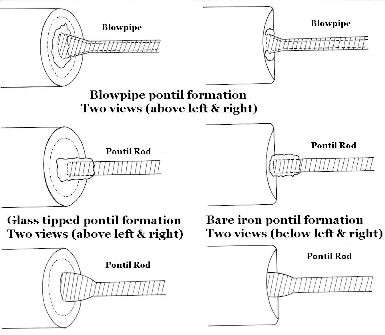Pontil Sea Glass Pieces
1st Apr 2016
Just what are Pontil Sea Glass Pieces?

Pontil sea glass originates from only one beach in the world that we know of, Seaham England.
These amazing unique sea glass finds are beautiful and stunning to behold.
Our theory on these pieces confirmed and excepted by many glass and sea glass experts the world over, seems to be the most accurate theory of the origin of these beautiful beach gems.
A Primer on Seaham Sea Glass
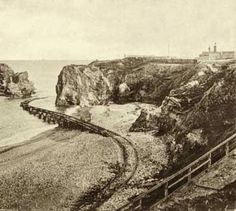
You need to know a little about the sea glass that washes up on this small hamlets beach to begin. Glass factories once dominated the area in the mid 1800's the beginning of the industrial age. There were many factories in the area, some producing art glass for Victorian homes, some producing hand blown bottles the all of Europe.
From 1853 until 1921, the Candlish Bottle Works produced over 20,000 of hand blown bottles a day. Dawdon pit, near Seaham closed and the sea dumping of colliery waste, discards of broken attempts and slap (cullet) glass into local waters were ended. This practice accounts for a bulk of the sea glass found in Seaham (specially on Blast Beach outside of Seaham) - HOWEVER, this glass was mostly of the common to uncommon colors and was generally a solid shade. Bottles produced at the factory ranged from brown, black (not truly black but deep thick greens and browns), seafoam or pale green and of course white and off white pieces.
However this poses the question of the most sought after sea glass in the world, the brightly colored and multi colored sea glass that washes up on this towns shores.
These pieces could not have originated from such utilitarian glass used in bottle making.
You can also view our page Our Collections - Where our sea glass comes from that includes many photos and info on this sea glass.
The Seaham Multi Colored Sea Glass
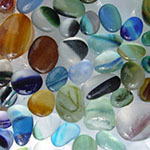
The Seaham multi and Seaham Brights could only be the result of art glass factories that existed further up the beach in the Tyne and Wear region and in Sunderland, the glass making capital of England. Though we have not been able to find the names of these companies, you can witness products made by this skilled artisans at the National Glass Centre in Sunderland.
The National Glass Centre is still at the heart of glass making today, using the same techniques that were employed over 150 years ago.
So Seaham Multies and Pontil Pieces, where do THEY come from?
Our theory ( though it is just that, only a theory), is that many of the multi colored pieces of sea glass originated as leftovers of the color mixing process in glass making. You see, colorants are added to glass when it is flowing or molten. These colorants are added to the glass in a mixing crucible next to the kiln. A blob of whitish glass is gathered on a punty, and then rolled in the colorant or mineral until it is incorporated. When this is done, layers build up on the side of the crucible. When this coloring crucible is cleaned ( and the glass has hardened), the Seaham Multi is born. These Crucible scraps were discarded into the Tyne and Wear and the North Sea and now was up on Seaham Beach.
But what about the Pontil Pieces?
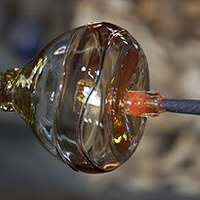
Again, it is just this artists theory but I can only imagine that they started out as pontil or punty tips. A pontil or punty is the large metal rod used to gather molten glass from the kiln (also called a gather). The rod is generally tipped with a cheaper glass (like white or an uncolored pale green).
Once the punty is ready, the more expensive color glass like blues, reds, pinks etc., are attached to the molten white punty piece. When the final product is finished, the punty end is heated, pulled and snapped off, and the punty tip discarded, in this case, into the North Sea.
You can read MORE about glass making on the best glass site online
Historic Glass Bottle Identification & Information Website

When you examine a Seaham Fish Eye (what we are calling a pontil piece), in many cases you can see how the glass inside of the glass continued to stretch as the outside became stable and cooled. If you have ever worked with molten glass or even sugar, you understand how this works.
Again this is only one artists theory though it is the accepted theory the world over on the origin of these unique sea glass pieces. In fact one of the worlds leading experts in sea glass, Dr. Beachcomb, seems to have accepted our theory as well, (see Dr. Beachcombs blog at https://drbeachcomb.wordpress.com/2016/01/20/english-sea-glass/) as well as most other sea glass experts.
Though other theories exist, ours seems the most credible and most well accepted
More about glass making
From time to time, we offer sea glass pontil pieces set in gold and silver. Here are a few examples of past work that we have done.
For current Pontil Sea Glass Jewelry Pieces please visit THIS LINK!

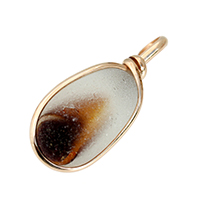

Share:


